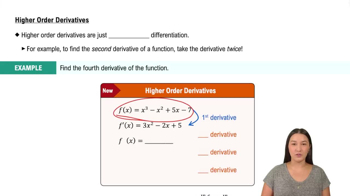Textbook Question
Find f′(x), f′′(x), and f′′′(x) for the following functions.
f(x) = (x2 - 7x - 8) / (x + 1)
 Verified step by step guidance
Verified step by step guidance Verified video answer for a similar problem:
Verified video answer for a similar problem:



 2:42m
2:42mMaster Higher Order Derivatives with a bite sized video explanation from Patrick
Start learning